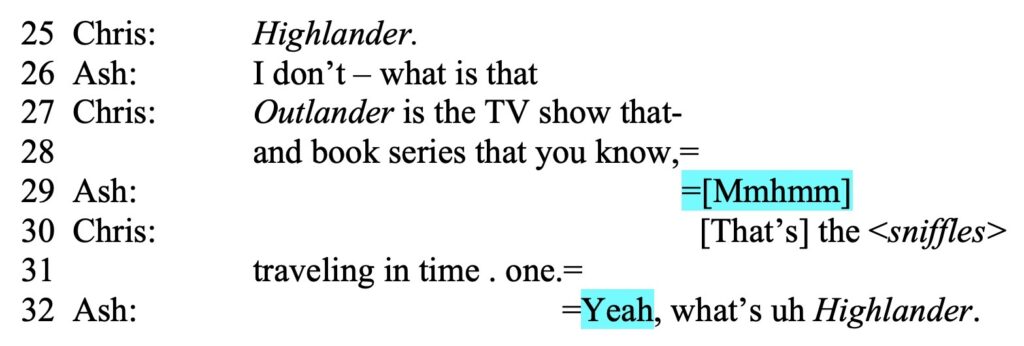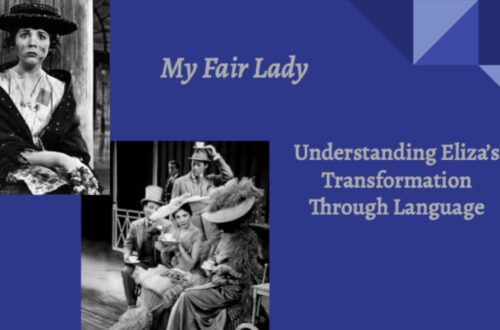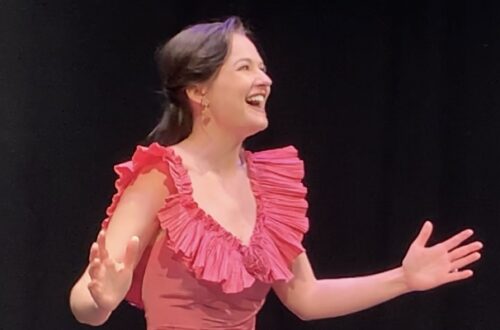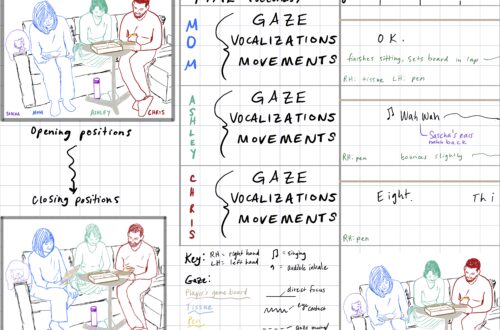Schegloff (1982) and Listener Backchannels
Georgetown University, 2020.
Hi, everyone! Today’s #WeeklyWednesday is a presentation I gave recently for a Linguistics course in Discourse Analysis of Conversation at Georgetown University. I hope you enjoy seeing some of what I’m working on there!
Part of this course has included recording and transcribing an excerpt from a conversation that we were a part of (mine is with my fiancé). This assignment is applying a particular course reading to my conversational data. Below are some key points from the reading and a video of my presentation. I hope you enjoy it!
READING APPLIED:
Schegloff (1982) “Discourse as an interactional achievement: Some uses of ‘uh huh’ and other things that come between sentences”
Key Points:
* Conversation is an “achievement”
* Listener behavior influences speakers
“‘Back-channel’ actions” (74)
– Consider in context
– Two generalizations:
1. Show that recipient understands that a turn is not finished and consents to the current speaker’s continuation (“continuers,” 81).
2. Waive an opportunity for repair, such as clarifying or disagreeing with the previous speech.
Thank you for checking out my work, and I hope you enjoy this introduction to Schegloff (1982) and my studies in Linguistics!
#AshleyWagnerArts
Sharing the short paper I wrote for this presentation: “Contextual Uses of Backchannels in Interaction”

Though the above are lifted from popular songs, similar vocalizations are found in everyday dialogue such as taunting, contradictions, and refusals (i.e., as a way of saying ‘no’); the only way to determine the source and meaning of these ‘na’s is by referencing contextual information. In music, such non-lexical vocables are frequently used by backup singers to support a soloist, with this behavior sometimes occurring improvisationally (in response to cues from each other and the audience), shaping the way a performance develops. Spoken interactions operate similarly in their responsiveness to emergent behavior by all participants and inclusion of small, contextually-meaningful ‘support’ utterances offered by non-primary speakers.
Schegloff (1982) investigates these aspects of discourse, highlighting the role of the recipient(s) of speech in shaping conversation, where the act of speaking (including content and delivery), is heavily influenced by recipient behavior in real-time. A frequent form of recipient feedbackare brief utterances that take the place of a full speech turn (e.g., ‘yeah’ and ‘mmhmm’), termed “backchannel” actions (Yngve 1970). Schegloff demonstrates that such utterances shape interactionsand that users strategically employ backchannels to accomplish a wide range of functions. Much of this meaning is discernable only in the context of a backchannel’s particular usage in a specific interaction, though two generalizations about function may be made: backchannels may serve as “continuers” (81), by which recipients signal understanding that a turn is not finished and consent to the current speaker’s continuation; and as devices to waive “other-initiated repair” (87), such as clarifying or disagreeing with the previous speech. In this paper, through examples from a dyadic interchange, I will demonstrate how one interlocutor’s verbal backchannel actions work to shape emerging discourse, emphasizing the necessity of examining such utterances in context to understand their function.
The selected backchannels are from a conversation between my fiancé, Chris, and myself; I employ them in response to Chris’ explanations of two different entertainment programs. In each case, the function of the specific words I use and their overall effect on the conversation are evident only by considering them in relation to their local context.
The following excerpt is representative of numerous instances from this interaction of backchannels functioning as continuers. Chris has begun explaining the plot and characters of the movie and television show The Highlander, with which I am unfamiliar. He is the principal speaker, and I use backchannels to encourage him to continue his explanation.[2]

By line 40, Chris has expressed a complete thought and finished a “turn-constructional unit” – a point at which I could begin a full speech turn (720: Sacks, Schegloff, and Jefferson 1974). Instead, in lines 41 and 43, I respond quietly with “[m]m” and “[t]hat’s cool.” I use these backchannels to waive my opportunity for a full turn,signal my interest in Chris’ description, and demonstrate that I would like him to continue. My “O:: H!” in line 45 operates similarly, though its phonological elements of duration, intensity, and pitch mark it as different from the previous continuers. In line 44, Chris reveals that these Highlanders are immortal; from this immediate context, one can infer excitement and surprise from my ‘oh’ – and in light of the broader context of the interaction, it marks my first significant display of interest in Chris’ topic. Not only is this ‘oh’ a continuer: its paralinguistic cues mark it as an enthusiastic invitation, shaping the conversation by encouraging Chris to expand on this topic (which he accepts, elaborating in his upcoming turns).
The next two examples occurred earlier in our conversation. Through a joke, Chris referenced (but did not name) The Highlander. In the excerpt below, Chris provides the title of the program, with which I initially think I am familiar. Upon reflection, I realize that I am not; because I think he may have mistaken the title, I offer him an opportunity for repair.

The Highlander (line 21) sounds like a current television show that we have watched together. I respond with the backchannel “[o]h” (line 22) using falling intonation and moderately-loud dynamic intensity that suggests familiarity. This ‘oh’ could have functioned as a continuer or an option to waive repair; however, I soon realize that I do not recognize The Highlander and think Chris may have meant Outlander instead. At line 23, I initiate repair, which influences the direction of the conversation by prompting Chris to reconsider his reference. This usage is consistent with Schegloff’s findings that when backchannels initially waive repair, they still make available the option for future repair (88). As with each of the previous backchannels discussed, without considering this ‘oh’ in context, its function would be obscure.
The final extract immediately follows the previous discourse. After Chris confirms his source as The Highlander, I request information about it. Instead, Chris describes Outlander.

With my question in line 26, “what is that,” I am asking Chris to tell me about The Highlander, but he begins by clarifying Outlander. My “[m]mhmm” in line 29 waives repair, shows my agreement with his statements about that show, and further, was intended to encourage Chris to proceed with describing The Highlander. Instead, he uses his next turn (lines 30-31) to provide further information about Outlander. My response in line 32 demonstrates some impatience with this delay. I first respond with a very short “yeah,” which could have been a continuer – but rather than allowing Chris’ turn to continue (and possibly linger further on Outlander), I initiate a full turn that allows me to steer the conversation in the direction I want. In his next turn, Chris will be compelled either to respond to my specific question or flout conversational norms by ignoring it. Apart from this contextual information, my ‘mmhmm’ and ‘yeah’ could appear to have very different meanings (e.g., comparable to the first continuers discussed in lines 41 and 43).
In these examples, each backchannel has been employed in a particular way to accomplish a certain function, which affected the nature of the conversation that emerged. Without considering these backchannels’ phonological aspects and locations in the surrounding discourse, most of their specific meanings – and their overall effects on the speech that follows – would be lost. This supports Schegloff’s assertions that, while certain generalizations may be made, to approach thorough understanding of a backchannel’s function and its influence on the conversation as a whole, it must be considered in its particular interactional context.
References
Pickett, W. (1966). Land of 1000 Dances [Song]. Atlantic Recording Corporation.
Sacks, H., Schegloff, E. A., & Jefferson, G. (1974). A Simplest Systematics for the Organization of Turn-Taking for Conversation. Language, 50(4), 696-735.
Schegloff, E. A. (1982). Discourseas an interactional achievement: Some uses of ‘uh huh’ and other things that come between sentences. In D. Tannen (ed.), Analyzing Discourse: Text and Talk. Washington, DC: Georgetown University Press.
Steam (1969). Na Na Hey Hey Kiss Him Goodbye [Song]. Fontana Records.
The Beatles (1968). Hey Jude [Song]. Apple Records.
Yngve, V. (1970). On getting a word in edgewise. In Papers from the Sixth Regional Meeting, Chicago Linguistic Society. (pp. 567-577). Chicago: Chicago Linguistic Society.
Notes
[1] Wilson Pickett: “Land of 1000 Dances.” The Beatles: “Hey Jude.” Steam: “Na Na Hey Hey Kiss Him Goodbye”
[2] I have numbered my conversation excerpt lines according to where they appear in the complete transcript (attached) for easy reference (e.g., the first line that appears in this paper is line 2. Rather than renumbering it as “line 1,” I have continued to label it “line 2”). Additionally, my transcription conventions are indicated on the complete transcript.




